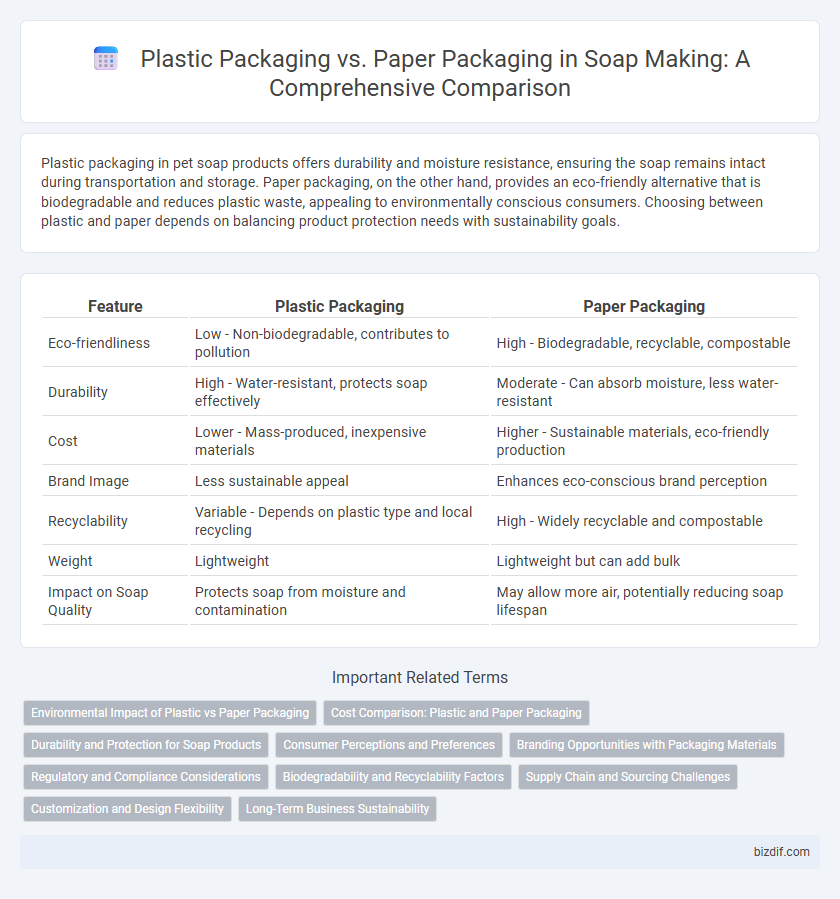Plastic packaging in pet soap products offers durability and moisture resistance, ensuring the soap remains intact during transportation and storage. Paper packaging, on the other hand, provides an eco-friendly alternative that is biodegradable and reduces plastic waste, appealing to environmentally conscious consumers. Choosing between plastic and paper depends on balancing product protection needs with sustainability goals.
Table of Comparison
| Feature | Plastic Packaging | Paper Packaging |
|---|---|---|
| Eco-friendliness | Low - Non-biodegradable, contributes to pollution | High - Biodegradable, recyclable, compostable |
| Durability | High - Water-resistant, protects soap effectively | Moderate - Can absorb moisture, less water-resistant |
| Cost | Lower - Mass-produced, inexpensive materials | Higher - Sustainable materials, eco-friendly production |
| Brand Image | Less sustainable appeal | Enhances eco-conscious brand perception |
| Recyclability | Variable - Depends on plastic type and local recycling | High - Widely recyclable and compostable |
| Weight | Lightweight | Lightweight but can add bulk |
| Impact on Soap Quality | Protects soap from moisture and contamination | May allow more air, potentially reducing soap lifespan |
Environmental Impact of Plastic vs Paper Packaging
Plastic packaging in soap making contributes significantly to environmental pollution due to its non-biodegradable nature and persistence in landfills and oceans, releasing harmful microplastics. In contrast, paper packaging offers a sustainable alternative as it is biodegradable, recyclable, and derived from renewable resources, reducing landfill waste and carbon footprint. Choosing paper packaging supports circular economy principles by minimizing environmental impact and promoting responsible consumption in soap production.
Cost Comparison: Plastic and Paper Packaging
Plastic packaging for soap products typically offers lower initial costs due to cheaper raw materials and streamlined manufacturing processes, making it a cost-effective choice for mass production. Paper packaging, while often more expensive upfront because of higher material and printing costs, provides eco-friendly benefits and can justify premium pricing through sustainable branding. Long-term cost analysis must consider factors like waste management, consumer preferences, and regulatory incentives that increasingly favor biodegradable options over plastic.
Durability and Protection for Soap Products
Plastic packaging offers superior durability and moisture resistance, preventing soap products from damage and preserving their shelf life effectively. Paper packaging, while more environmentally friendly, tends to be less protective against water and physical impact, increasing the risk of soap degradation. Selecting plastic packaging ensures enhanced protection during shipping and storage, maintaining soap quality and customer satisfaction.
Consumer Perceptions and Preferences
Consumers increasingly perceive paper packaging for soap as eco-friendly and sustainable, enhancing brand appeal and trust. Plastic packaging, while offering durability and moisture protection, often faces criticism for environmental impact and lower recyclability. Preference trends indicate a growing demand for biodegradable materials, with many buyers willing to pay a premium for soap wrapped in recyclable or compostable paper packaging.
Branding Opportunities with Packaging Materials
Plastic packaging offers vibrant colors and durable textures that enhance brand visibility and long-term product protection, appealing to consumers seeking premium soap products. Paper packaging provides eco-friendly, customizable surfaces that align with sustainable branding and attract environmentally conscious buyers, reinforcing a commitment to natural ingredients. Selecting packaging materials strategically boosts brand identity, customer loyalty, and market differentiation in the competitive soap industry.
Regulatory and Compliance Considerations
Plastic packaging in soap making often faces stringent regulations due to environmental impact concerns, including restrictions on single-use plastics under legislation such as the EU's Single-Use Plastics Directive. Paper packaging complies more easily with biodegradable and compostability standards, aligning with increasing regulatory requirements for sustainable materials in personal care products. Ensuring compliance with FDA and EU cosmetic packaging regulations is essential for both materials, but paper's lower environmental footprint supports adherence to emerging global mandates on plastic reduction.
Biodegradability and Recyclability Factors
Paper packaging in soap making offers superior biodegradability compared to plastic, breaking down naturally within weeks without leaving harmful residues. Recyclability rates for paper are higher due to widespread recycling infrastructure, whereas plastic packaging often requires specialized facilities and can persist in the environment for centuries. Choosing paper packaging reduces environmental impact by minimizing landfill waste and promoting sustainable resource cycles in soap product distribution.
Supply Chain and Sourcing Challenges
Plastic packaging in soap making offers durability and moisture resistance but poses significant environmental concerns, leading to increased regulatory scrutiny and supply chain disruptions. Paper packaging presents a sustainable alternative with improved biodegradability, yet sourcing high-quality, moisture-resistant paper materials remains challenging and can result in higher costs and limited supplier availability. Balancing these factors, manufacturers navigate complex logistics and material sourcing to maintain product integrity while meeting consumer demand for eco-friendly packaging solutions.
Customization and Design Flexibility
Plastic packaging offers extensive customization options with vibrant colors, intricate shapes, and durable finishes, ideal for enhancing soap branding and shelf appeal. Paper packaging provides eco-friendly design flexibility, allowing for unique textures, biodegradable inks, and embossing that resonate with environmentally conscious consumers. Brands seeking a balance between aesthetic versatility and sustainability often combine both materials to optimize customer engagement and product differentiation.
Long-Term Business Sustainability
Plastic packaging in soap making offers durability and moisture resistance, but presents significant environmental challenges due to its non-biodegradable nature and contribution to landfill waste. Paper packaging, often made from recycled and biodegradable materials, aligns better with long-term sustainability goals by reducing carbon footprints and promoting circular economy principles. Brands prioritizing eco-friendly packaging can enhance consumer trust, comply with stringent environmental regulations, and secure a competitive advantage in the sustainable personal care market.
Plastic Packaging vs Paper Packaging Infographic

 bizdif.com
bizdif.com